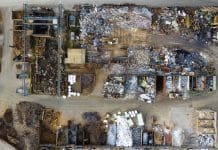The first of 38 steel beams that will be used to build the low-carbon structure of HS2’s Wendover Dean Viaduct has arrived on site ahead of the start of deck construction
The steel beam travelled 560 miles from France to the Wendover Dean Viaduct, travelling at night to avoid disruption to local communities.
Crafted at a specialised facility in France by Eiffage Metal, each of the 40-tonne beams is made of ‘weathering steel,’ a material that gradually develops a rich, dark brown colour as it weathers over time. This steel variant was made specially to blend in with the surrounding scenery.
Reducing concrete and steel at the Wendover Dean Viaduct
Located in Buckinghamshire, just south of Wendover village, the 450-meter-long viaduct is set to become the pioneering railway bridge in the UK, featuring a unique ‘double composite’ structure. This design reduces carbon-intensive concrete and steel, setting it apart from conventional construction approaches.
EKFB, the primary works contractor for HS2 Ltd, comprising Eiffage, Kier, Ferrovial Construction, and BAM Nuttall, will assemble the beams over the summer. The beams will be integrated into the initial 90-meter-long span, one of five spans planned for the viaduct. Once complete, these spans will be carefully moved onto the viaduct piers later this year.
“It’s great to see the first beams arrive on site. These huge pieces of steel will play a vital role in the innovative double composite structure of the viaduct deck – and help us cut the amount of embedded carbon in the structure,” said HS2 project client, Neil Winterburn.
“As well as offering zero-carbon rail travel from day one, it’s also important that we reduce the amount of carbon-intensive steel and concrete we use in construction. That’s why this viaduct, and this structural design, is so important,” he continued.
EKFB developed the double composite methodology with ASC and architects from Moxon. The method drew inspiration from the structures used in the renowned French high-speed TGV network.
A new approach to viaduct construction
Unlike the conventional approach of using solid pre-stressed concrete beams to build the bridge spans, the Wendover Dean Viaduct will incorporate two steel beams within layers of reinforced concrete, resulting in a robust yet lightweight hollow span.
The spans will be assembled on-site, with pre-cast concrete sections integrated to form the distinctive box-shaped structure. These assembled sections will be gradually pushed outward from the northern abutment onto the corresponding concrete piers.
“There’s been a tremendous amount of effort put in to get to this stage of construction, including an extensive earthworks and utilities programme and beam delivery is a key milestone for the team,” said EKFB’s senior engineer James Collings.
“As momentum gathers pace and we continue our preparations for the bridge deck launch, it’s great to see these steels on site, ready for the next phase of the build. We’re starting to see the viaduct emerge from its foundations and start to take shape above ground,” he added.
Construction has begun on the towering piers that will support the viaduct’s deck. These piers consist of stacked hollow pre-cast concrete shells filled with concrete and steel reinforcement. This approach ensures a clean external finish, reduces on-site work, and minimises disruption for locals.
HS2 will improve travel by linking London, Birmingham, and the North, freeing up space for more freight and local services. The trains will be powered by zero-carbon electricity and able to accommodate up to 1,100 passengers.







![[VIDEO] HS2 completes 4,600-tonne viaduct slide across M6 The HS2 team completed a 17-hour long operation sliding the viaduct structure across the M6 without closing the motorway](https://www.pbctoday.co.uk/news/wp-content/uploads/2025/12/M6-South-viaduct-slide-taking-place-across-a-live-motorway-December-2025-218x150.jpg)







